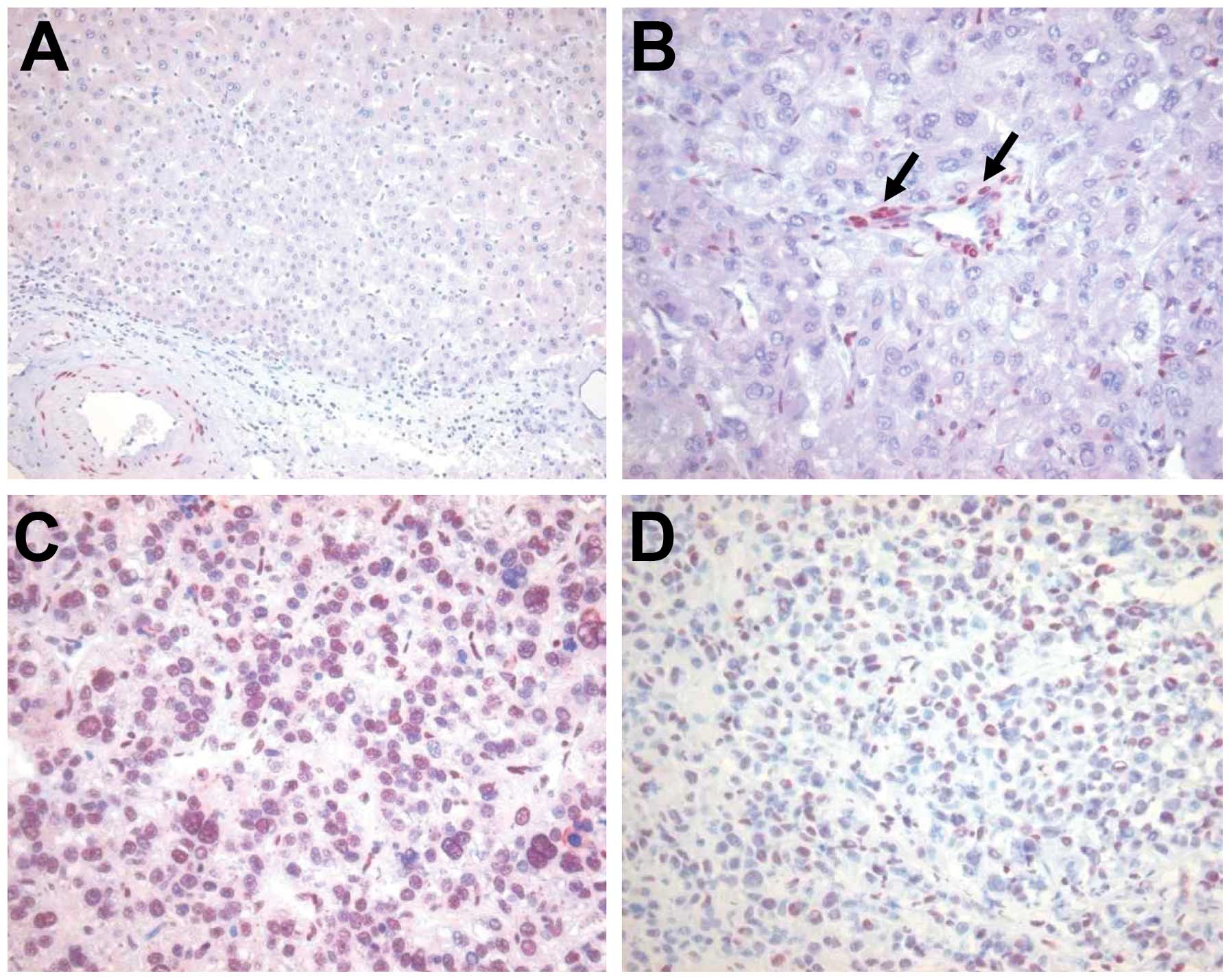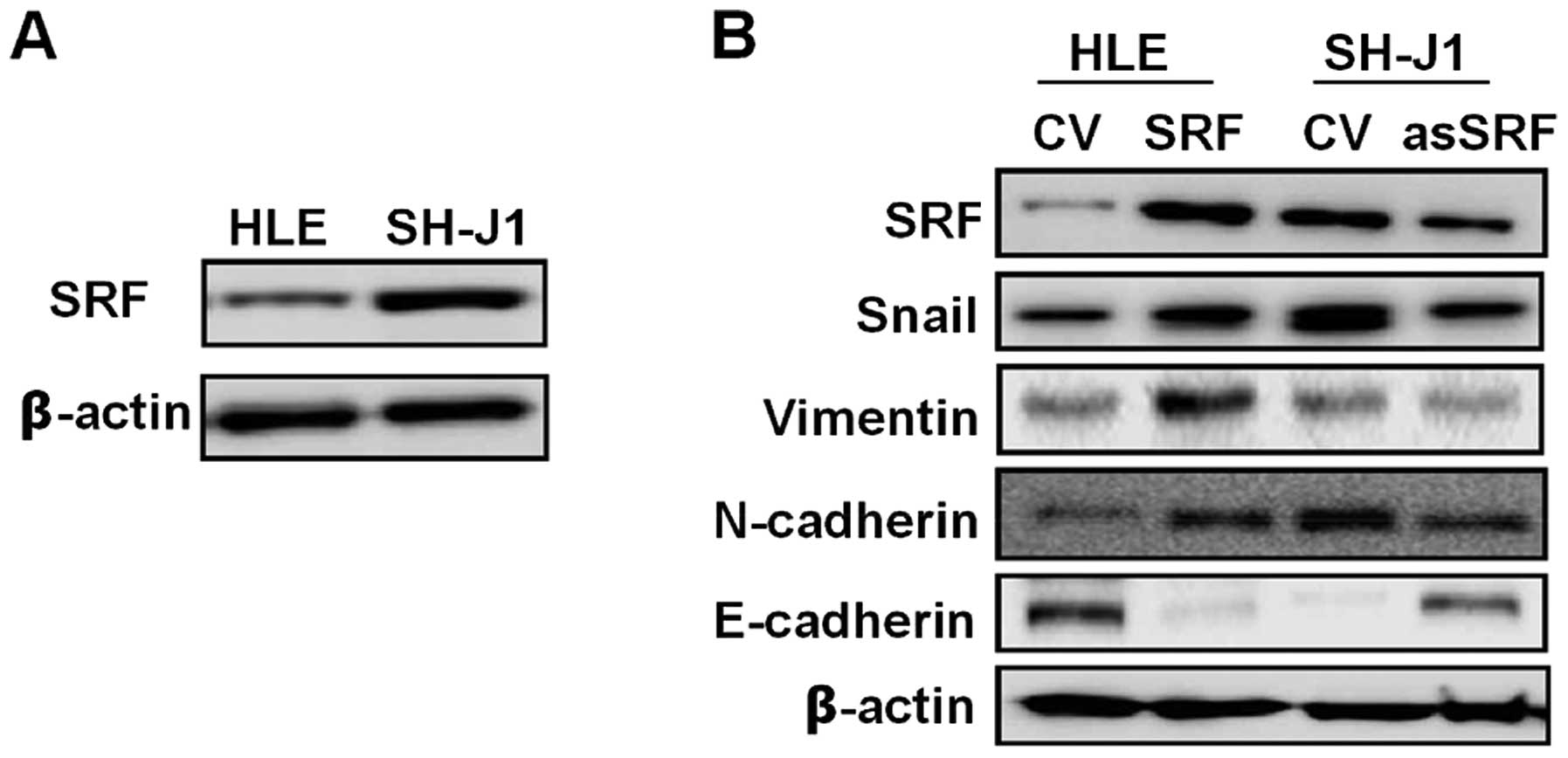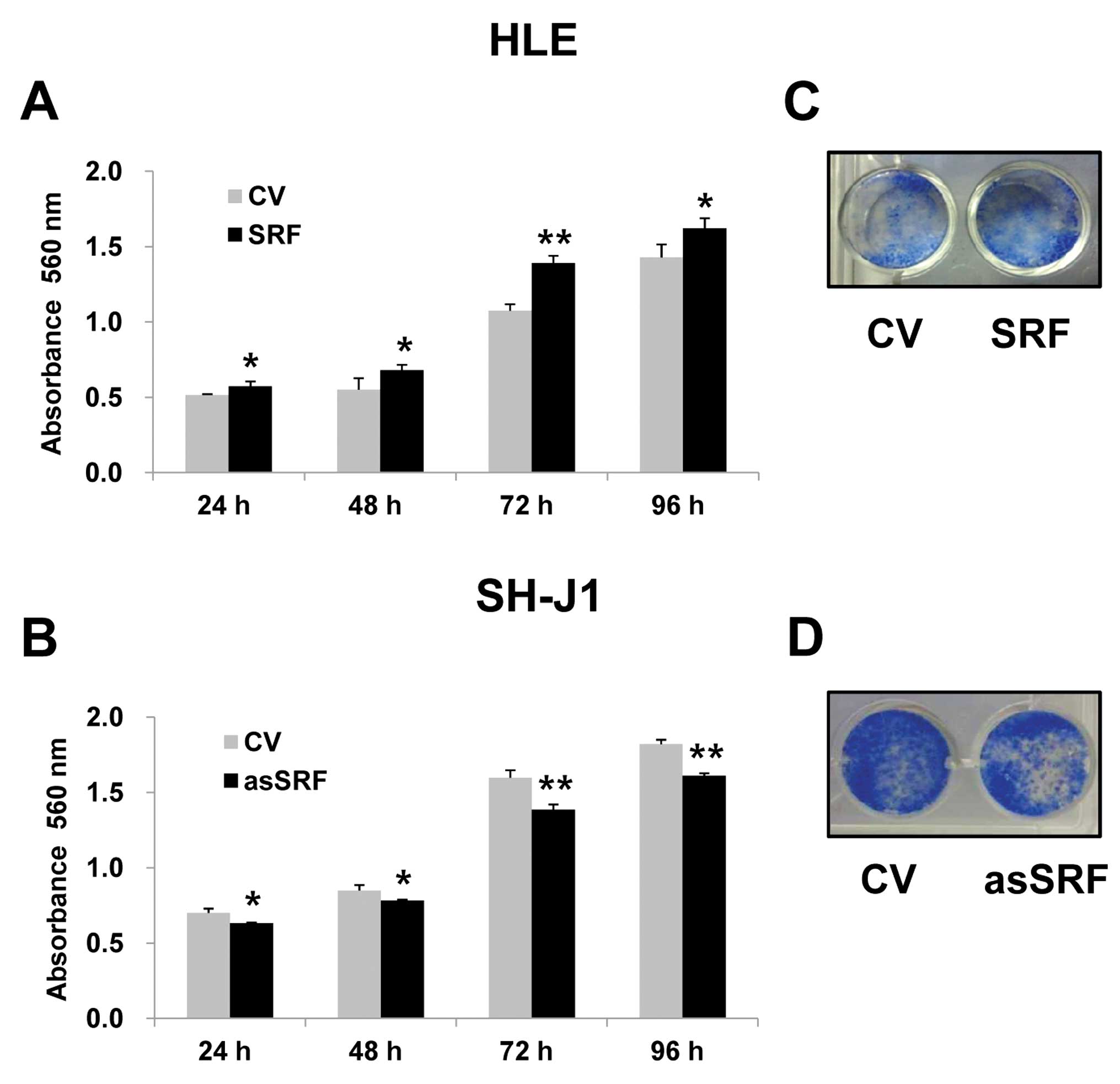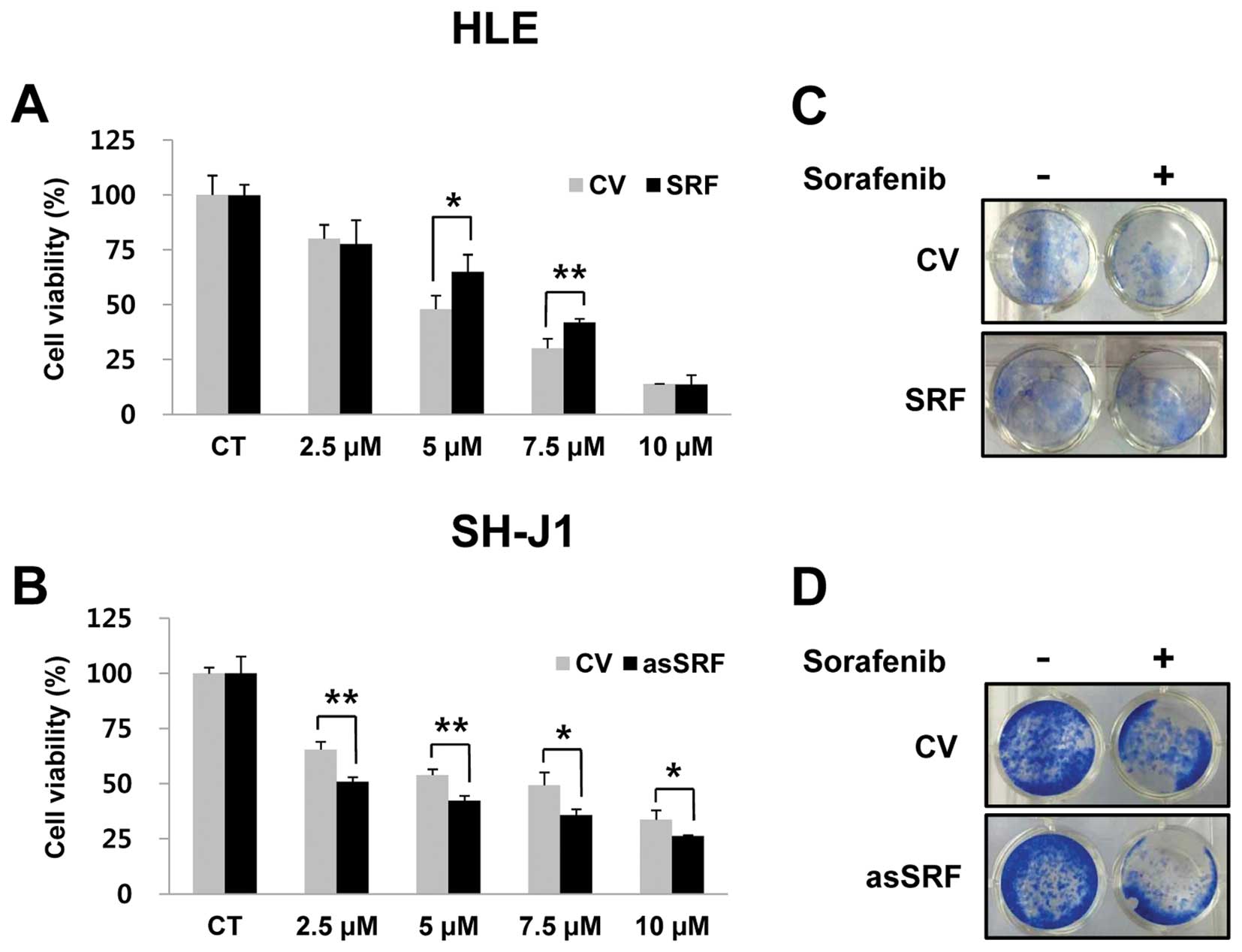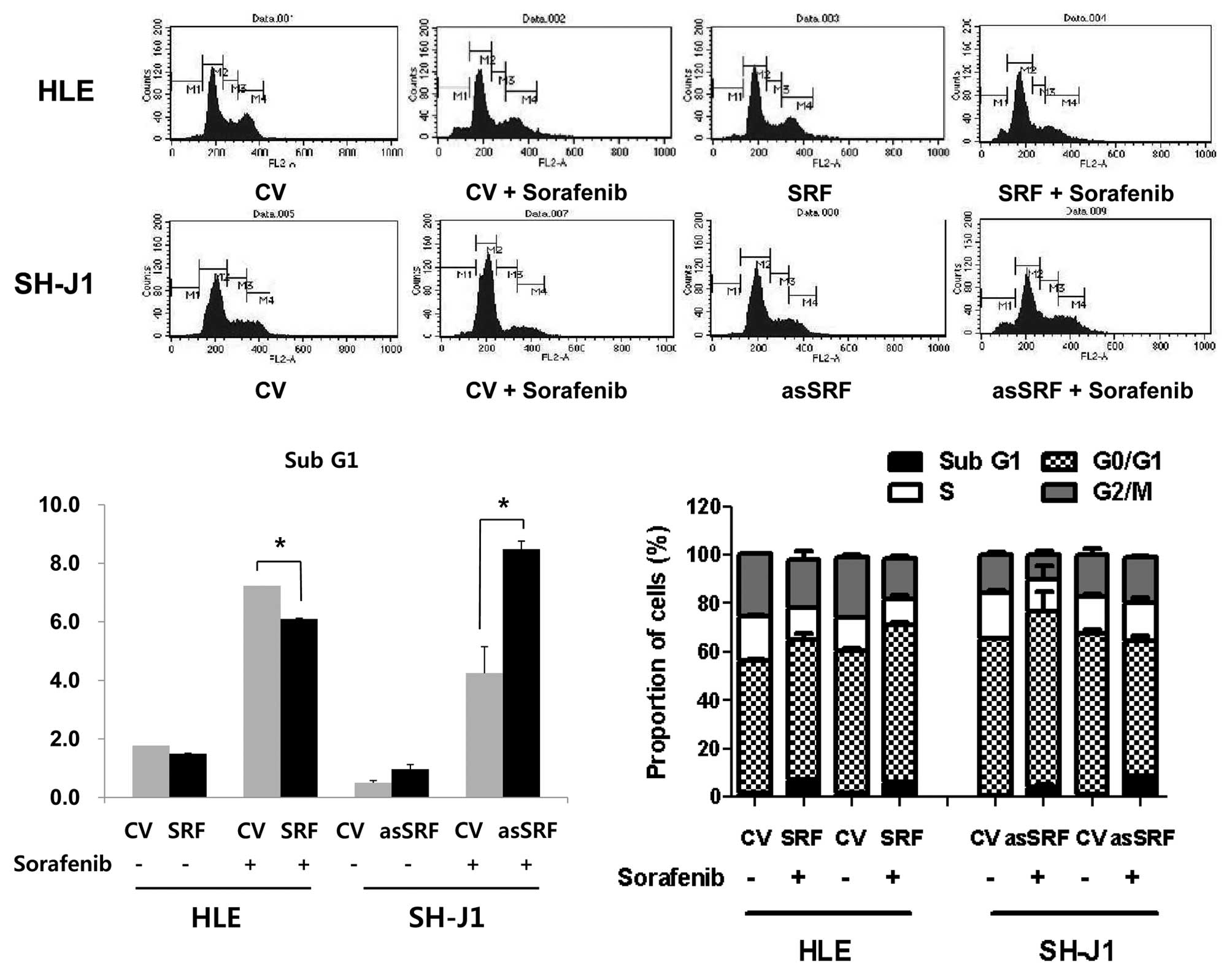|
1.
|
El-Serag HB: Epidemiology of viral
hepatitis and hepatocellular carcinoma. Gastroenterology.
142:1264–1273. 2012. View Article : Google Scholar : PubMed/NCBI
|
|
2.
|
Ferlay J, Shin HR, Bray F, Forman D,
Mathers C and Parkin DM: Estimates of worldwide burden of cancer in
2008: GLOBOCAN 2008. Int J Cancer. 127:2893–2917. 2010. View Article : Google Scholar : PubMed/NCBI
|
|
3.
|
Avila MA, Berasain C, Sangro B and Prieto
J: New therapies for hepatocellular carcinoma. Oncogene.
25:3866–3884. 2006. View Article : Google Scholar : PubMed/NCBI
|
|
4.
|
Polyak K and Weinberg RA: Transitions
between epithelial and mesenchymal states: acquisition of malignant
and stem cell traits. Nat Rev Cancer. 9:265–273. 2009. View Article : Google Scholar : PubMed/NCBI
|
|
5.
|
Kalluri R and Weinberg RA: The basics of
epithelial-mesenchymal transition. J Clin Invest. 119:1420–1428.
2009. View
Article : Google Scholar : PubMed/NCBI
|
|
6.
|
Creighton CJ, Li X, Landis M, et al:
Residual breast cancers after conventional therapy display
mesenchymal as well as tumor-initiating features. Proc Natl Acad
Sci USA. 106:13820–13825. 2009. View Article : Google Scholar : PubMed/NCBI
|
|
7.
|
Singh A and Settleman J: EMT, cancer stem
cells and drug resistance: an emerging axis of evil in the war on
cancer. Oncogene. 29:4741–4751. 2010. View Article : Google Scholar : PubMed/NCBI
|
|
8.
|
Kurrey NK, Jalgaonkar SP, Joglekar AV, et
al: Snail and slug mediate radioresistance and chemoresistance by
antagonizing P53-mediated apoptosis and acquiring a stem-like
phenotype in ovarian cancer cells. Stem Cells. 27:2059–2068. 2009.
View Article : Google Scholar : PubMed/NCBI
|
|
9.
|
Wang Z, Li Y, Kong D, et al: Acquisition
of epithelialmesenchymal transition phenotype of
gemcitabine-resistant pancreatic cancer cells is linked with
activation of the notch signaling pathway. Cancer Res.
69:2400–2407. 2009. View Article : Google Scholar : PubMed/NCBI
|
|
10.
|
Peinado H, Olmeda D and Cano A: Snail, ZEB
and bHLH factors in tumour progression: an alliance against the
epithelial phenotype? Nat Rev Cancer. 7:415–428. 2007. View Article : Google Scholar : PubMed/NCBI
|
|
11.
|
Treisman R: Identification of a
protein-binding site that mediates transcriptional response of the
c-fos gene to serum factors. Cell. 46:567–574. 1986. View Article : Google Scholar : PubMed/NCBI
|
|
12.
|
Treisman R: Identification and
purification of a polypeptide that binds to the c-fos serum
response element. EMBO J. 6:2711–2717. 1987.PubMed/NCBI
|
|
13.
|
Shore P and Sharrocks AD: The MADS-box
family of transcription factors. Eur J Biochem. 229:1–3. 1995.
View Article : Google Scholar : PubMed/NCBI
|
|
14.
|
Modak C and Chai J: Serum response factor:
look into the gut. World J Gastroenterol. 16:2195–2201. 2010.
View Article : Google Scholar : PubMed/NCBI
|
|
15.
|
Miano JM: Role of serum response factor in
the pathogenesis of disease. Lab Invest. 90:1274–1284. 2010.
View Article : Google Scholar : PubMed/NCBI
|
|
16.
|
Psichari E, Balmain A, Plows D,
Zoumpourlis V and Pintzas A: High activity of serum response factor
in the mesenchymal transition of epithelial tumor cells is
regulated by RhoA signaling. J Biol Chem. 277:29490–29495. 2002.
View Article : Google Scholar : PubMed/NCBI
|
|
17.
|
Park MY, Kim KR, Park HS, et al:
Expression of the serum response factor in hepatocellular
carcinoma: Implications for epithelial-mesenchymal transition. Int
J Oncol. 31:1309–1315. 2007.PubMed/NCBI
|
|
18.
|
Kwon CY, Kim KR, Choi HN, et al: The role
of serum response factor in hepatocellular carcinoma: Implications
for disease progression. Int J Oncol. 37:837–844. 2010.PubMed/NCBI
|
|
19.
|
Choi HN, Kim KR, Lee JH, et al: Serum
response factor enhances liver metastasis of colorectal carcinoma
via alteration of the E-cadherin/β-catenin complex. Oncol Rep.
21:57–63. 2009.PubMed/NCBI
|
|
20.
|
Farra R, Dapas B, Pozzato G, et al: Serum
response factor depletion affects the proliferation of the
hepatocellular carcinoma cells HepG2 and JHH6. Biochimie.
92:455–463. 2010. View Article : Google Scholar : PubMed/NCBI
|
|
21.
|
Wilhelm S, Carter C, Lynch M, et al:
Discovery and development of sorafenib: a multikinase inhibitor for
treating cancer. Nat Rev Drug Discov. 5:835–844. 2006. View Article : Google Scholar : PubMed/NCBI
|
|
22.
|
Wilhelm SM, Adnane L, Newell P, Villanueva
A, Llovet JM and Lynch M: Preclinical overview of sorafenib, a
multikinase inhibitor that targets both Raf and VEGF and PDGF
receptor tyrosine kinase signaling. Mol Cancer Ther. 7:3129–3140.
2008. View Article : Google Scholar : PubMed/NCBI
|
|
23.
|
Kane RC, Farrell AT, Madabushi R, et al:
Sorafenib for the treatment of unresectable hepatocellular
carcinoma. Oncologist. 14:95–100. 2009. View Article : Google Scholar : PubMed/NCBI
|
|
24.
|
Edge SB, Byrd DR, Compton CC, Fritz AG,
Greene FL and Trotti A: AJCC Cancer Staging Manual. 7th edition.
Springer; New York, NY: 2010
|
|
25.
|
Kim DG, Park SY, Kim H, Chun YH, Moon WS
and Park SH: A comprehensive karyotypic analysis on a newly
established sarcomatoid hepatocellular carcinoma cell line SH-J1 by
comparative genomic hybridization and chromosome painting. Cancer
Genet Cytogenet. 132:120–124. 2002. View Article : Google Scholar
|
|
26.
|
Bae JS, Choi HN, Noh SJ, et al: Expression
of K19 and K7 in dysplastic nodules and hepatocellular carcinoma.
Oncol Lett. 4:213–220. 2012.PubMed/NCBI
|
|
27.
|
Kim KR, Choi HN, Lee HJ, et al: A
peroxisome proliferator-activated receptor γ antagonist induces
vimentin cleavage and inhibits invasion in high-grade
hepatocellular carcinoma. Oncol Rep. 18:825–832. 2007.
|
|
28.
|
Cano A, Pérez-Moreno MA, Rodrigo I, et al:
The transcription factor Snail controls epithelial-mesenchymal
transitions by repressing E-cadherin expression. Nat Cell Biol.
2:76–83. 2000. View
Article : Google Scholar : PubMed/NCBI
|
|
29.
|
Park SY, Jang KY, Kim YN, et al:
Expression and prognostic significance of serum response factor in
cholangiocarcinoma. Korean J Pathol. 43:517–522. 2009. View Article : Google Scholar
|
|
30.
|
Kim KR, Bae JS, Choi HN, et al: The role
of serum response factor in hepatocellular carcinoma: An
association with matrix metalloproteinase. Oncol Rep. 26:1567–1572.
2011.PubMed/NCBI
|
|
31.
|
Gauthier A and Ho M: Role of sorafenib in
the treatment of advanced hepatocellular carcinoma: an update.
Hepatol Res. 43:147–154. 2013. View Article : Google Scholar : PubMed/NCBI
|
|
32.
|
Kajiyama H, Shibata K, Terauchi M, et al:
Chemoresistance to paclitaxel induces epithelial-mesenchymal
transition and enhances metastatic potential for epithelial ovarian
carcinoma cells. Int J Oncol. 31:277–283. 2007.
|
|
33.
|
Yang AD, Fan F, Camp ER, et al: Chronic
oxaliplatin resistance induces epithelial-to-mesenchymal transition
in colorectal cancer cell lines. Clin Cancer Res. 12:4147–4153.
2006. View Article : Google Scholar : PubMed/NCBI
|
|
34.
|
Rho JK, Choi YJ, Lee JK, et al: Epithelial
to mesenchymal transition derived from repeated exposure to
gefitinib determines the sensitivity to EGFR inhibitors in A549, a
non-small cell lung cancer cell line. Lung Cancer. 63:219–226.
2009. View Article : Google Scholar : PubMed/NCBI
|
|
35.
|
Van Malenstein H, Dekervel J, Verslype C,
et al: Long-term exposure to sorafenib of liver cancer cells
induces resistance with epithelial-to-mesenchymal transition,
increased invasion and risk of rebound growth. Cancer Lett.
329:74–83. 2013.PubMed/NCBI
|
|
36.
|
Huang XY, Ke AW, Shi GM, et al:
αB-crystallin complexes with 14-3-3ζ to induce
epithelial-mesenchymal transition and resistance to sorafenib in
hepatocellular carcinoma. Hepatology. 57:2235–2247. 2013.
|
|
37.
|
Nagai T, Arao T, Furuta K, et al:
Sorafenib inhibits the hepatocyte growth factor-mediated epithelial
mesenchymal transition in hepatocellular carcinoma. Mol Cancer
Ther. 10:169–177. 2011. View Article : Google Scholar
|
|
38.
|
Yu W, Feng S, Dakhova O, et al: FGFR-4
Arg388 enhances prostate cancer progression via
extracellular signal-related kinase and serum response factor
signaling. Clin Cancer Res. 17:4355–4366. 2011.
|
|
39.
|
Prencipe M, Madden SF, O’Neill A, et al:
Identification of transcription factors associated with
castration-resistance: is the serum responsive factor a potential
therapeutic target? Prostate. 73:743–753. 2013. View Article : Google Scholar : PubMed/NCBI
|
|
40.
|
Pérez-Saborido B, de los Galanes SJ,
Menéu-Díaz JC, et al: Tumor recurrence after liver transplantation
for hepatocellular carcinoma: recurrence pathway and prognostic
factors. Transplant Proc. 39:2304–2307. 2007.PubMed/NCBI
|
|
41.
|
Medjkane S, Perez-Sanchez C, Gaggioli C,
Sahai E and Treisman R: Myocardin-related transcription factors and
SRF are required for cytoskeletal dynamics and experimental
metastasis. Nat Cell Biol. 11:257–268. 2009. View Article : Google Scholar : PubMed/NCBI
|
|
42.
|
Bai S, Nasser MW, Wang B, et al:
MicroRNA-122 inhibits tumorigenic properties of hepatocellular
carcinoma cells and sensitizes these cells to sorafenib. J Biol
Chem. 284:32015–32027. 2009. View Article : Google Scholar : PubMed/NCBI
|















